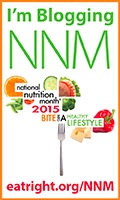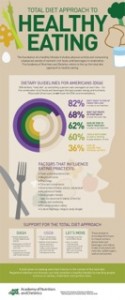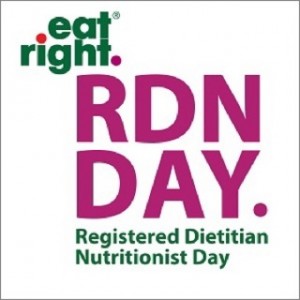
Lifestyle matters! This year’s National Nutrition Month® (NNM) is “BITE INTO A HEALTHY LIFESTYLE ” with the spotlight on YOU!
The Academy of Nutrition and Dietetics is encouraging you to review your own lifestyle. Consider what might work best for YOU to promote your overall health and well-being. (Note that all images in this blog post are the property of the Academy of Nutrition and Dietetics and only displayed in honor of the Academy’s celebration of National Nutrition Month® and National Registered Dietitian Nutritionist Day).
Adopting a healthier lifestyle involves individual choices. It involves focusing on the basics of eating and fitness habits you already have.
Are your current food and fitness choices helping to promote a healthier lifestyle for you?
It’s up to you to consider:
●How can you best achieve and maintain a weight you feel healthy at?
●How can you reduce your risk of chronic disease(s) and their complications?
●How can you potentially improve your overall quality of life in terms of overall health and well-being?
Making Informed Lifestyle Food Choices
One very important part of any lifestyle equation involves making informed food choices, preferably with an eye towards choosing healthier-for-you options.
Although various agencies and organizations may make dietary suggestions referencing population-based health information, those are always going to be GENERAL dietary guidelines. They are NOT intended as being specific to any one person’s unique health situation. Rather, the licensed health care professional(s) you utilize to address your health care needs should consider your unique situation when you consult with them. Working together, the goal is to mutually develop a lifestyle plan truly individualized just for you.
(Remember that this site only provides general infotainment. You are urged to utilize your own licensed health care practitioners for personalized health care input tailored specifically for YOU).
The Academy of Nutrition and Dietetics (the Academy) is an organization which will always reinforce general population-based dietary guidelines when it comes to lifestyle. An example is reinforcing the US government’s Dietary Guidelines for Americans (DGAs), with the 2010 DGAs* having been released on 31JAN2011. Currently, updated DGAs are released ~every five years through joint efforts of the Department of Health & Human Services (DHHS) as well as the Department of Agriculture (USDA).

When you check out the Academy’s Total Diet Approach to Healthy Eating infographic addressing lifestyle, keep that caveat in mind.
Besides highlighting the DGAs, the Academy’s infographic also brings up the DASH Diet approach, USDA MyPlate Food Guidance System, and the First Lady’s “Let’s Move” Campaign for improving the overall quality of children’s diets and increasing their physical activity (hoping that combining the two efforts will reduce child obesity levels).
That infographic reflects the Position of the Academy titled “Total Diet Approach to Healthy Eating” dated February 2013 and references the 2010 DGAs.
The 2015 Dietary Guidelines Advisory Committee (DGAC) of experts has already submitted their Scientific Report to the Secretaries of each of those government agencies. On 19FEB2015 the report** was made public via the Federal Register and the Dietary Guidelines website. (A shorter piece from DEc 2014 is the Science Base Chapter: Food and Nutrient Intakes, and Health: Current Status and Trends). Keep in mind that the Scientific Report is only advisory in nature, and the determination of the final DGAs is in fact made by staff at DHHS & USDA.
Broad, general guidelines concerning lifestyle that are released by DHHS & USDA do affect policy and thus various government programs serving segments of the national population, so they do impact each community in some way. Nonetheless, the advice is still GENERAL and aimed to influence the entire general population of a large country of millions of people, hoping to improve national health, especially in light of rising health care costs that impact the national budget.
DGAs are NOT meant to be specific for any one individual–namely, you! It is important that you confer with the licensed health care professionals overseeing your care to give them the opportunity to always consider your unique situation in regard to your lifestyle. It is their responsibility to interpret & apply known information based upon good quality research and practical application experience in their own and their colleague’s experience when working with each individual under their care. Such an effort utilizes what is often called an evidence-based practice approach when counseling clients regarding lifestyle.
Engaging in Lifestyle Regular Physical Activity
Also keep in mind that making informed positive food choices for you is only one part of engaging in a healthier lifestyle. Another part is engaging in regular physical activity, preferably through daily exercise aimed toward improving/maintaining your physical fitness.
Paraphrasing Jennifer McDaniel, Academy spokesperson, potential benefits of regular exercise can include a more positive mental attitude and feeling better about yourself, enjoying a better quality of sleep, and experiencing relief from some of the stress of modern life–totaling up to an overall healthier lifestyle.
When it comes to your physical activity, consider how much you “move” now in terms of regular physical activity as part of your lifestyle. The Academy spokesperson notes it is important to keep in mind that your bones and muscles benefit when you are able to help strengthen them through regular movement. That is especially true as the intensity level of any exercise trends toward a moderate level.
She goes on to mention that how long you exercise during the course of each week also matters. Although daily activity is preferable, getting at least ~150 minutes of total exercise each week (trending towards a moderate level) can promote a healthier lifestyle for many of us.
Take Lifestyle Action This March!
Do something positive for yourself this March.
“Bite into a healthy lifestyle” through choices you make when it comes to both food and exercise as the Academy advises for NNM for the general public.
Look for tweets about NNM on Twitter using the hashtag #NNM.

RDN DAY is on March 11th this year, so if you don’t already have a personal RDN, take the opportunity to learn more about one by checking out this RDN Day Fact Sheet.
If you want advice that is personalized just for you, then consult with a Registered Dietitian (RD) aka Registered Dietitian Nutritionist (RDN) in your area who is accepting new clients and is willing to work with your physician and other licensed health care providers on your team.
*The 2010 DGAs came out as a lengthy booklet after the 2010 DGAC of experts submitted their report to the respective Secretary of each of those government agencies (DHHS & USDA). Per report, “…Very little of the 2010 DGAC report was reflected in the 2010 Dietary Guidelines.” Per a member of the 2010 DGAC, Roger Clemens, who gave a presentation entitled “U.S. Dietary Guidelines: History or Hysteria” at the Ohio State University Food Innovation Center 20NOV2014 held conference on “The New Dietary Guidelines for Americans: Preparing for the 2015 Release,” the actual 2010 DGAs were developed by the two government agencies involved. It was ~6 months later that the DGAC members found out about the actual content of the 2010 DGAs on the Friday before they were officially released on January 31, 2011.
**It is up to the Secretaries of those two federal government agencies as to exactly what content winds up being in the actual 2015DGAs that are eventually released sometime this year.

